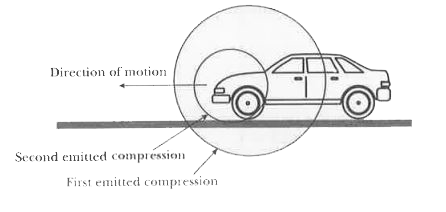The car in the figure is moving to the left at 35 m/s. The car's horn continuously emits a 2.20×102 Hz sound. The figure also shows the first two regions of compression of the emitted sound waves. The speed of sound is 343 m/s.

How far has the initial compression traveled when the second compression is emitted?
0.77 m
7.7 m
1.56 m
15.5 m
The correct Answer is:C
Step by step video, text & image solution for The car in the figure is moving to the left at 35 m/s. The car's horn continuously emits a 2.20 xx 10^2 Hz sound. The figure also shows the first two regions of compression of the emitted sound waves. The speed of sound is 343 m/s. How far has the initial compression traveled when the second compression is emitted? by Physics experts to help you in doubts & scoring excellent marks in Class 12 exams.
Updated on:21/07/2023Topper's Solved these Questions
- WAVE - IIBOOK - RESNICK AND HALLIDAYCHAPTER - WAVE - IIEXERCISE - PRACTICE QUESTIONS (MATRIX MATCH)
4 Videos
- WAVE - IIBOOK - RESNICK AND HALLIDAYCHAPTER - WAVE - IIEXERCISE - PRACTICE QUESTIONS (INTEGER TYPE)
5 Videos
- WAVE - IIBOOK - RESNICK AND HALLIDAYCHAPTER - WAVE - IIEXERCISE - PRACTICE QUESTIONS (MORE THAN ONE CORRECT CHOICE TYPE)
6 Videos
- VECTORS BOOK - RESNICK AND HALLIDAYCHAPTER - VECTORS EXERCISE - PRACTICE QUESTIONS
39 Videos
- WAVES-IBOOK - RESNICK AND HALLIDAYCHAPTER - WAVES-IEXERCISE - Practice Questions (Integer Type)
4 Videos
Similar Questions
The distance between a compression and the next rarefaction of a sound wave is 12.5 cm. If the sound waves can travel 750 m in 3s, then find the number of waves produced in one second
View SolutionThe distance between a compression and the next rarefaction of a sound wave is 12.5 cm. If the sound waves can travel 750 m in 3s, then find the number of waves produced in one second
View Solution
Knowledge Check
The car in the figure is moving to the left at 35 m/s. The car's horn continuously emits a 2.20×102 Hz sound. The figure also shows the first two regions of compression of the emitted sound waves. The speed of sound is 343 m/s.

How far does the car move in one period of the sound emitted from the horn?A0.08mB0.16mC8mD16mThe car in the figure is moving to the left at 35 m/s. The car's horn continuously emits a 2.20×102 Hz sound. The figure also shows the first two regions of compression of the emitted sound waves. The speed of sound is 343 m/s.

What is the wavelength of the sound in the direction of motion of the car?A1.40 mB1.70 mC1.56 mD1.93 mThe car in the figure is moving to the left at 35 m/s. The car's horn continuously emits a 2.20×102 Hz sound. The figure also shows the first two regions of compression of the emitted sound waves. The speed of sound is 343 m/s.

What is the frequency heard by a stationary observer standing in front of the car?A9.7 HzB245 HzC176 HzD219 Hz
A car moving at 35 m/s approaches a stationary whistle that emits a 220 Hz sound. The speed of sound is 343 m/s. What is the speed of the sound relative to the driver of the car?
View SolutionA fire whistle emits a tone of 170 Hz. Take the speed of sound in air to be 340 m/s. The wavelength of this sound is about
View SolutionA car moving at 20m/s with its horn blowing (n = 1200 Hz) is chasing another car going at 15m/s. What is the apparent frequency of the horn as heard by the driver being chased? Take the speed of the sound to be 340m/s:
View SolutionA police car horn emits a sound at a frequency 240 Hz when the car is at rest. If the speed of sound is 330m/s, the frequency heard by an observer who is approaching the car at a speed of 11m/s is :
View SolutionA police car horn emits a sound at a frequency 240 Hz when the car is at rest. If the speed of sound is 330m/s, the frequency heard by an observer who is approaching the car at a speed of 11m/s is :
View Solution
